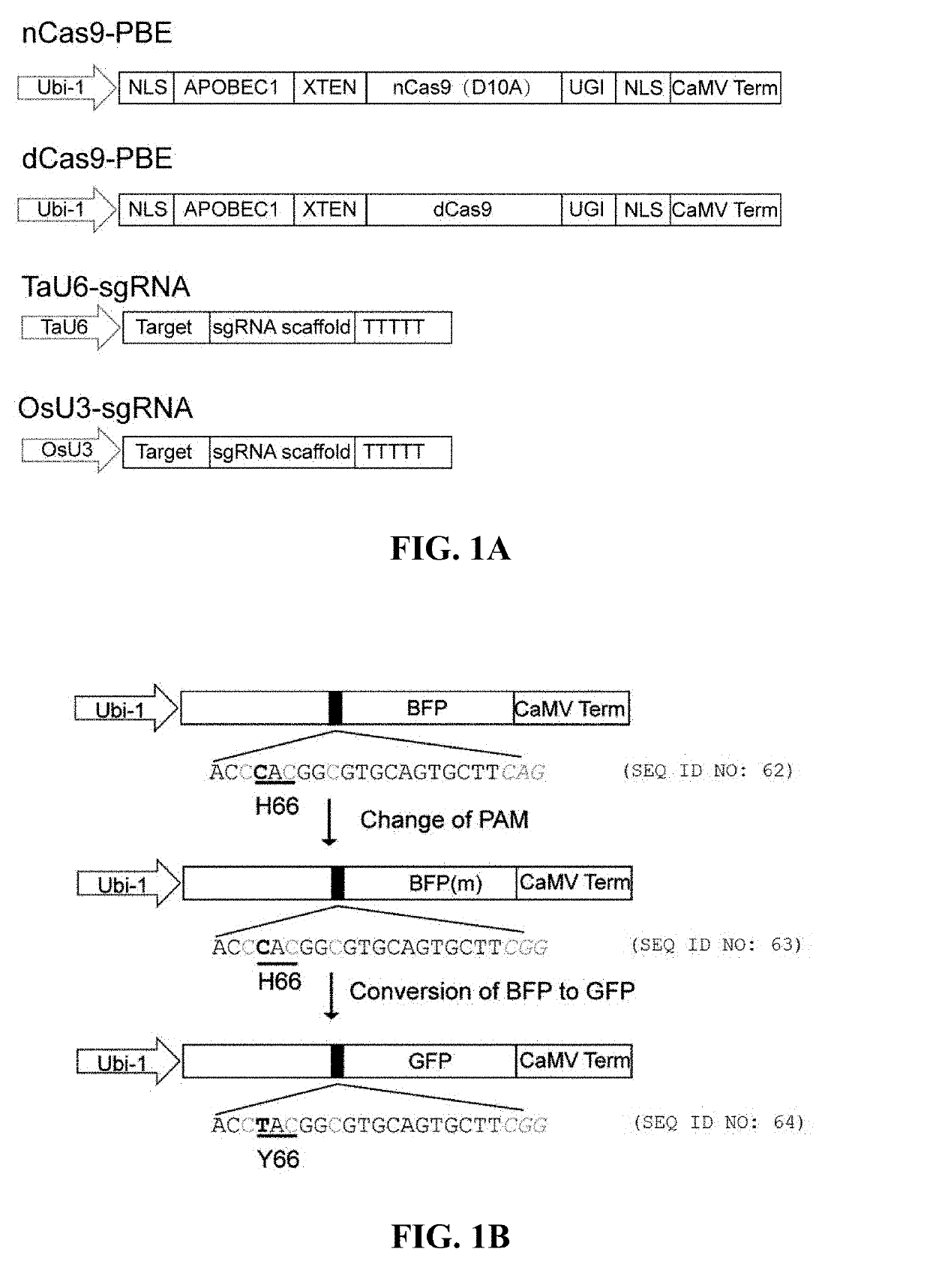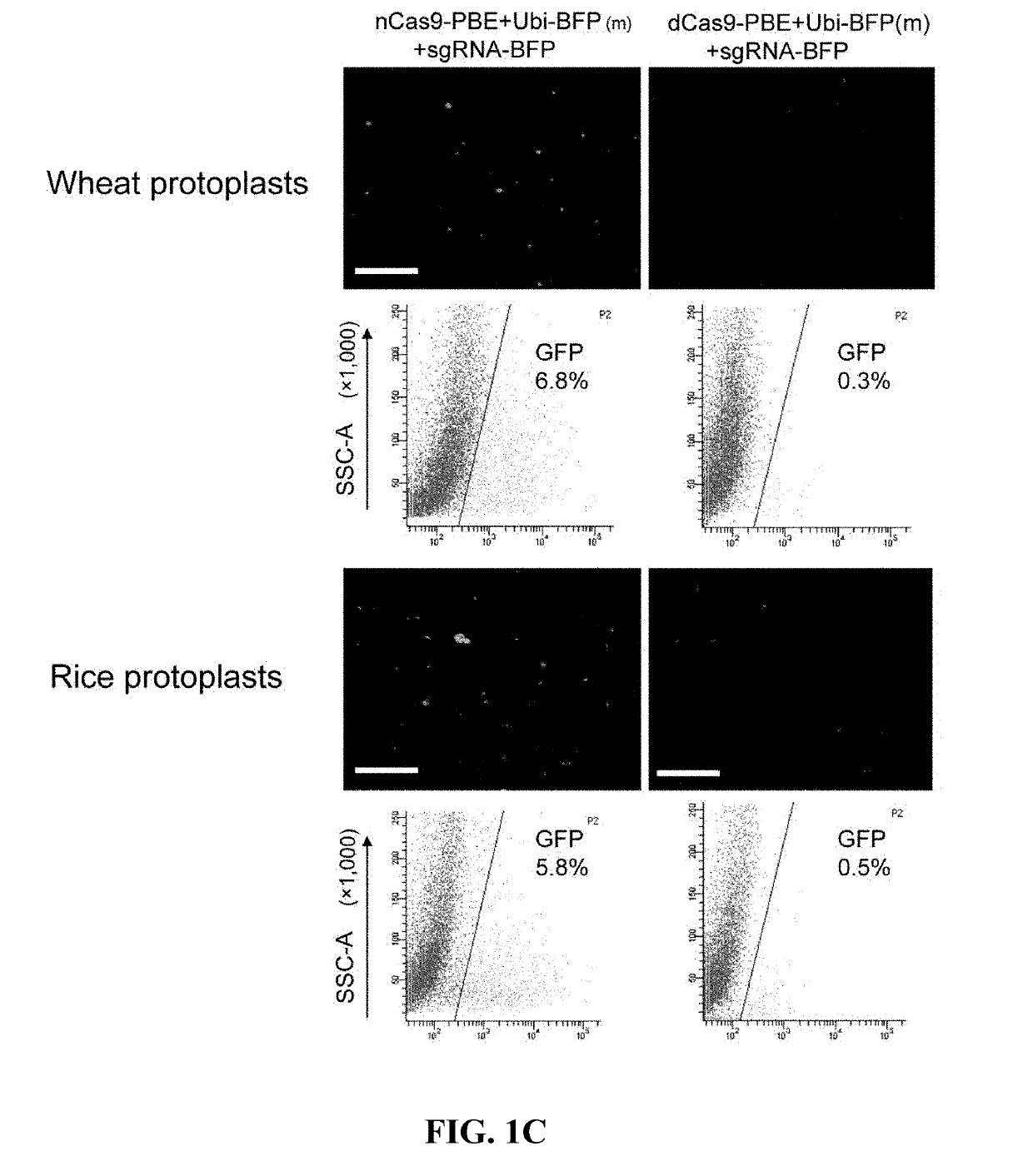A method for base editing in plants
a plant and base editing technology, applied in the field of plant genetic engineering, can solve the problems of time-consuming and costly screening, limited number and repertoire of identified point mutations, and limited success rate of this method
- Summary
- Abstract
- Description
- Claims
- Application Information
AI Technical Summary
Benefits of technology
Problems solved by technology
Method used
Image
Examples
example 1
ing of BFP in Plant Protoplasts by nCas9-PBE and dCas9-PBE
[0156]In the nCas9-PBE fusion protein, from N-terminal to C-terminal are NLD (SEQ ID NO: 30), APOBEC1 (SEQ ID NO: 11), XTEN linker (SEQ ID NO: 12), Cas9 nickase (nCas9, SEQ ID NO: 13), uracil DNA glycosylase inhibitors (UGI, SEQ ID NO: 15) and NLS (SEQ ID NO: 31) respectively; whereas in the dCas9-PBE fusion protein, from N-terminal to C-terminal are NLS, APOBEC1, XTEN linkers, catalytically deactivated Cas9 (dCas9, SEQ ID NO: 14), UGI, and NLS, respectively. Codon-optimized fusion protein coding sequences for efficient expression in cereal crops were placed downstream of the Ubiquitin-1 gene promoter Ubi-1 in the plasmid constructs pnCas9-PBE and pdCas9-PBE (FIG. 1a).
[0157]The ability to convert blue fluorescent protein (BFP) into green fluorescent protein (GFP) of the two constructs in wheat and rice protoplasts was compared. This conversion involves mutating the first nucleotide of the 66th codon of the BFP encoding gene f...
example 2
ing of Endogenous Genes in Plant Protoplasts by nCas9-PBE and dCas9-PBE
[0164]In this example, the activity of pnCas9-PBE or pdCas9-PBE on wheat, rice, and maize endogenous genes was further studied. As a control for the induction of indel, a construct pwCas9 (Addgene ID53064) expressing wild-type Cas9 was also used in this experiment.
[0165]Three different sgRNA target sites (Si, S2, and S3) were designed in the TaLOX2 gene of wheat. For each of the three rice genes OsCDC48, OsNRT1.1B, and OsSPL14, one sgRNA target site was designed. One sgRNA target site was designed in maize ZmCENH3 gene (see Table 1).
[0166]Each sgRNA expression construct was combined with pnCas9-PBE, pdCas9-PBE, and pwCas9, respectively, and co-expressed in wheat, rice, and maize protoplasts, respectively. Protoplast DNA was extracted. PCR amplicons for seven different targets were prepared and sequenced. 100000 to 270000 sequencing reads were used for detailed analysis of the mutagenicity.
[0167]For pnCas9-PBE, C ...
example 3
for Mutant Plants
[0170]This example further investigated the functional differences between nCas9-PBE and dCas9-PBE and tested the functional properties of nCas9-PBE by analyzing mutant plants.
[0171]For wheat transformation, pnCas9-PBE and pTaU6-sgRNA-LOX2-s1 (FIG. 3a) were co-transformed into a bread wheat variety, Bobwhite by particle bombardment, and plants were regenerated without herbicide selection. The target site of sgRNA-LOX2-s1 was amplified from the genomic DNA of the regenerated plants using specific primers (Table 4). Two lines carrying nucleotide substitutions were identified from 160 immature embryos by T7EI and restriction enzyme digestion (PCR-RE). The mutation efficiency is 1.25% (2 / 160) (FIG. 3b). Sanger sequencing confirmed that the mutant T0-3 contains all three C to T substitutions at positions 3, 6, and 9 downstream of the PAM, whereas the mutant T0-7 carries a C to T mutation at position 3 (FIG. 3b). We failed to detect indels in these two mutant plants.
[0172...
PUM
| Property | Measurement | Unit |
|---|---|---|
| Electrical conductance | aaaaa | aaaaa |
| Fraction | aaaaa | aaaaa |
| Fraction | aaaaa | aaaaa |
Abstract
Description
Claims
Application Information
 Login to View More
Login to View More - R&D
- Intellectual Property
- Life Sciences
- Materials
- Tech Scout
- Unparalleled Data Quality
- Higher Quality Content
- 60% Fewer Hallucinations
Browse by: Latest US Patents, China's latest patents, Technical Efficacy Thesaurus, Application Domain, Technology Topic, Popular Technical Reports.
© 2025 PatSnap. All rights reserved.Legal|Privacy policy|Modern Slavery Act Transparency Statement|Sitemap|About US| Contact US: help@patsnap.com



